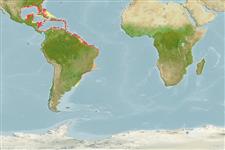>
Carangaria/misc (Various families in series Carangaria) >
Centropomidae (Snooks)
Etymology: Centropomus: Greek, kentron = sting + Greek, poma, -atos = cover, operculum (Ref. 45335).
More on author: Bloch.
Environment: milieu / climate zone / depth range / distribution range
Ecología
marino; agua dulce; salobre asociado a arrecife; anfidromo (Ref. 51243); rango de profundidad ? - 22 m (Ref. 26912). Tropical; 25°C - 31°C (Ref. 36880); 33°N - 35°S, 98°W - 33°W
Western Atlantic: southern Florida (USA), southeastern coast of the Gulf of Mexico, most of the Antilles and Caribbean coast of Central and South America extending southward to Rio de Janeiro, Brazil; also North Carolina and Texas, USA (Ref. 7251).
Length at first maturity / Tamaño / Peso / Age
Maturity: Lm ?, range 42 - ? cm
Max length : 140 cm TL macho / no sexado; (Ref. 9710); common length : 50.0 cm TL macho / no sexado; (Ref. 3713); peso máximo publicado: 24.3 kg (Ref. 4699); edad máxima reportada: 7 años (Ref. 12193)
Espinas dorsales (total) : 8 - 9; Radios blandos dorsales (total) : 10; Espinas anales: 3; Radios blandos anales: 6. 67- to 72 pored scales on lateral line to base of caudal fin (Ref. 26938). Black lateral line (Ref. 13442).
Adults inhabit coastal waters, estuaries and lagoons, penetrating into freshwater; usually at depths less than 20 m (Ref. 3713). Feed on fishes (Gobiidae, Gerreidae, Engraulidae) and crustaceans (shrimps and crabs) (Ref. 35237). Mature individuals congregate at mouths of passes and rivers during the spawning season, May through September (Ref. 3713). Seasonal movements into freshwater occur but poorly understood (Ref. 3713). Marketed fresh (Ref. 5712). Valued game fish and an excellent food fish (Ref. 26938). The world record for hook and line is a 53-lb., 10 ounce fish caught at Parismina Ranch, Costa Rica (Ref. 13442).
Also Ref. 103751.
Robins, C.R. and G.C. Ray, 1986. A field guide to Atlantic coast fishes of North America. Houghton Mifflin Company, Boston, U.S.A. 354 p. (Ref. 7251)
IUCN Red List Status (Ref. 130435)
Threat to humans
Harmless
Human uses
Pesquerías: comercial; Acuicultura: comercial; pesca deportiva: si
Herramientas
Special reports
Download XML
Fuentes de Internet
Estimates based on models
Preferred temperature (Ref.
123201): 23.5 - 28.1, mean 27.3 °C (based on 864 cells).
Phylogenetic diversity index (Ref.
82804): PD
50 = 0.5005 [Uniqueness, from 0.5 = low to 2.0 = high].
Bayesian length-weight: a=0.00741 (0.00587 - 0.00936), b=3.02 (2.97 - 3.07), in cm total length, based on LWR estimates for this species (Ref.
93245).
Nivel trófico (Ref.
69278): 4.2 ±0.6 se; based on diet studies.
Resiliencia (Ref.
120179): Medio, población duplicada en un tiempo mínimo de 1.4-4.4 años (K=0.3-0.49; tm=4; tmax=7; Fec=3 million).
Prior r = 0.87, 95% CL = 0.58 - 1.31, Based on 2 data-limited stock assessments.
Fishing Vulnerability (Ref.
59153): Moderate to high vulnerability (46 of 100).
Climate Vulnerability (Ref.
125649): Very high vulnerability (86 of 100).
Nutrients (Ref.
124155): Calcium = 25.4 [15.4, 38.4] mg/100g; Iron = 0.523 [0.319, 0.792] mg/100g; Protein = 20.3 [17.9, 22.5] %; Omega3 = 0.139 [0.065, 0.297] g/100g; Selenium = 34.5 [19.7, 59.5] μg/100g; VitaminA = 52.2 [18.4, 155.2] μg/100g; Zinc = 0.769 [0.560, 1.077] mg/100g (wet weight);
